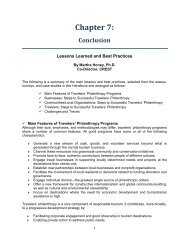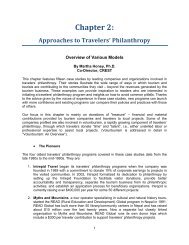Travelers' Philanthropy Handbook - Center for Responsible Travel
Travelers' Philanthropy Handbook - Center for Responsible Travel
Travelers' Philanthropy Handbook - Center for Responsible Travel
You also want an ePaper? Increase the reach of your titles
YUMPU automatically turns print PDFs into web optimized ePapers that Google loves.
evaluation, and audited data. Finance obviously needs <strong>for</strong>mal auditing, and in the “MaraBushbuck” project the number of surviving trees must also be independently audited.“Follow the money” has become one of Basecamp’s fundamental principals in its philanthropywork. An important reason <strong>for</strong> this is that donors seem more willing to give when they feel it isboth simple and safe to do so. And it doesn’t really matter if we are talking about “earmarked”funding, “basket” funding or “neuro-philanthropy” where several donors come together tocontribute to one large project -- as long as there is a governance system <strong>for</strong> transparency anddonor integrity.• Keep the Donors in the Loop of ThingsArguably, just as in the case of a business, one of the most important things in travelers’philanthropy is to maintain what you have previously worked up -- your donor market. AtBasecamp Foundation, we do not have a person dedicated full time to donor relationshipmanagement, although we would like to. With a growing project portfolio and multiple sources ofsupport, donors rapidly become many and it becomes difficult to stay “ahead of the game”without having established some reporting procedures. To handle this, Basecamp Foundationhas chosen to use standardreports <strong>for</strong> all donors.Two different types of standardreports are used, a “light”version <strong>for</strong> donors and a“heavy” version <strong>for</strong> the“Mother” Foundation, both sentout quarterly. The “heavy”version is also available <strong>for</strong>donors on request. The “light”donor version is a personalizedreport in the <strong>for</strong>m of a quarterlynewsletter, and a commondesign is used <strong>for</strong> all projects.Along with the newsletter youTourists at Basecamp Masai Mara, Kenya. Credit: Basecamp Foundationneed a database that keepstrack on the relationshipbetween donors and projects – you definitely do not want to send the wrong report to a donor.The “heavy” version is a project development and deviation report that comes with the project’saccount attached. Such a report may not be what a small donor wants to receive – but isimportant <strong>for</strong> project governance reasons.At the end of the year, a consolidated projects rep ort is produced <strong>for</strong> all projects <strong>for</strong> the purposeof auditing by an independent certified audit firm. The audited accounts and activities arereflected in the Annual Review, which is available by April/May the following year. The AnnualReview, as opposed to an annual report combines the previous year’s achievements, presentstatus, and points out the focus, aims and goals <strong>for</strong> the future. A copy of the Annual Review issent to each donor. This may all sound like quite tedious work. It is not too bad once theprocedures have been established, and we promise that it is the best investment you can makein managing donors. Never stop communicating with your donors – and mix the <strong>for</strong>malreports with light, compelling and fun stuff!133















